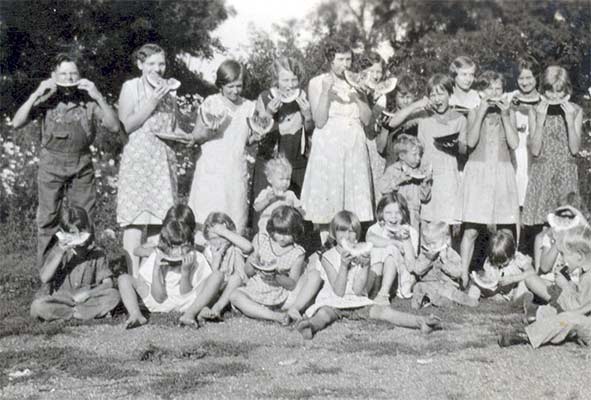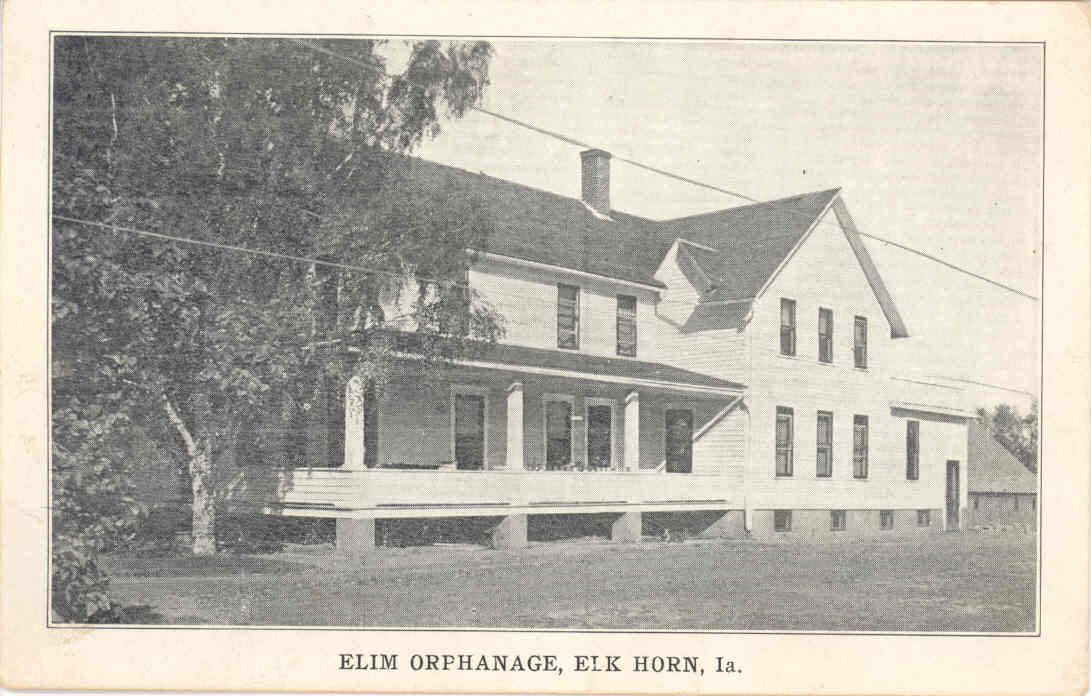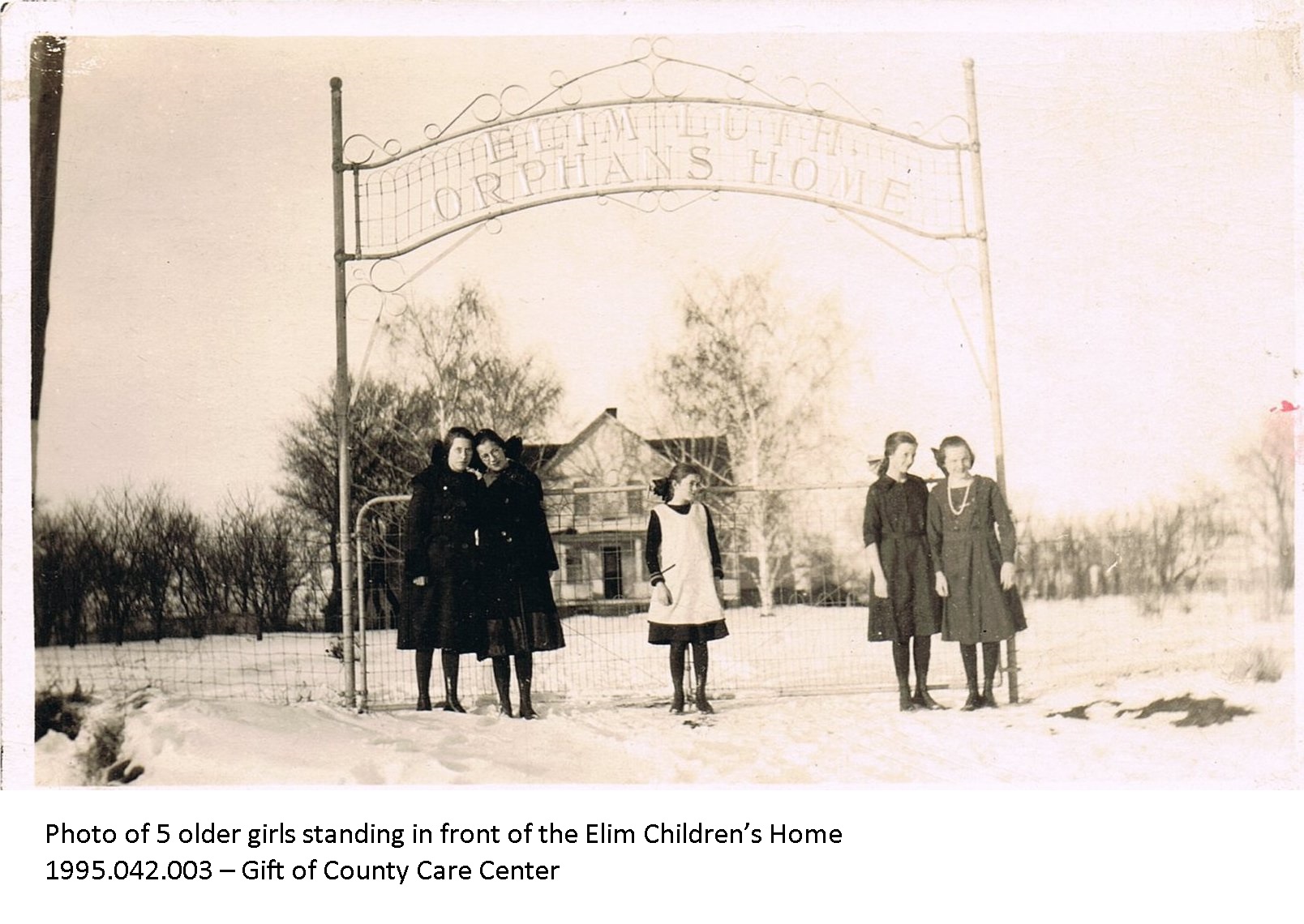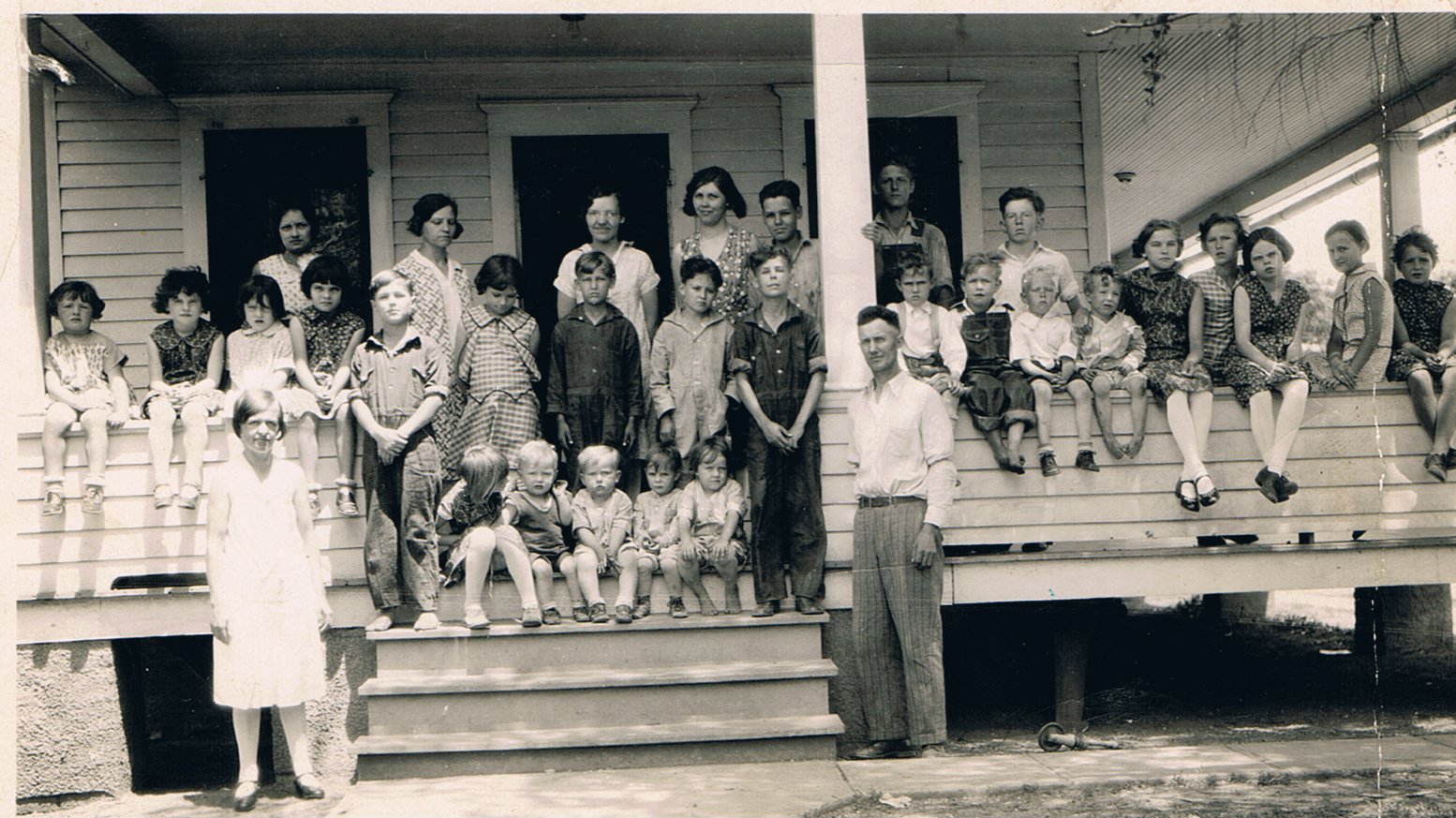Elim Children's Home
This exhibit is no longer on display.
Exhibition Type
temporaryShare this Exhibition
The Elim Children’s Home is featured in a display on the museum’s lower level, complete with photographs, memories, and the history of this important local landmark. Learn about the founding of the Elim home, the daily routine of the residents there, and even holiday high points and mishaps!
Exhibit text:
This is the story of a very special family that lived in Elk Horn, Iowa, for over 70 years. Their house was not far from where the Museum of Danish America stands now. It was called the Elim Children’s Home and during its years in Elk Horn the Elim family had almost 300 members, as many as 30 persons living under the same roof for periods of time. They were known in town as “the kids from the home.” The Elim Children’s Home was meant to be an orphanage, although as years went by it became clear that the home provided so much more for its residents – it provided a family and the possibility of a better future.
The Elim Children’s Home
Why Elim?
“And they came to Elim, where there were twelve wells of water and threescore and ten palm trees, and they encamped there” (Exodus 15.27).
Elim is described in the Bible as one of the places where the Israelites camped following their exodus from Egypt. In the same way that Elim provided an oasis for Moses and his people, the Elim Children’s Home of Elk Horn became a childhood oasis for more than 300 kids.
The Elim Children’s Home opened its doors in 1890. It provided a safe childhood which included a high school education, farming and housekeeping experience, as well as religious guidance.
The Elim Home was for kids of all ages, who all had different reasons for being there. In one case, a parent had passed away and the remaining parent couldn’t manage to care for the family alone. In another case, parents had divorced and couldn’t support the kids. Some kids would have faced abuse if they had stayed with their biological family. Some kids were orphans without immediate family to care for them.
The home
Danish immigrants started settling this area in the late 1860s, and by the late 1880s were building homes, churches, and a folk school. A local church congregation came up with the idea of establishing a place for homeless children, which in August 1889 led to a vote to proceed with the project. They looked at several sites in the area surrounding Elk Horn and decided on a 40-acre piece of land on the west side of town.
The Elim Children’s Home opened its doors on September 12, 1890, and it became the home of 6 children that first year. After two years it was necessary to build an addition to the home, as the number of kids had grown to 24.
Work and play
Living at the Elim Children’s Home meant no play without work. Everyone had their chores to do. There were cows to be fed and milked, crops to tend, a whole two-story house to clean and a lot of pants to patch. The home produced its own meat, eggs, milk, butter, fruits and vegetables. All was taken care of by children working side by side with the managers. The work became a part of their education and learning experience. Although it was a lot of work, there was also time to play. After picnic suppers outdoors in the summer months the older kids would play softball, basketball, or go roller skating.
A normal day at the Elim Children’s Home, described by Charleen Berdell Booth (resident 1942-1953):
“It began at 6 a.m. with either Palma (manager of the home from 1930 to 1961) or Margaret (assistant manager at the home from 1924-1950), calling each boy and girl by name. You knew what your job would be when you woke up each morning. Everything was strictly scheduled… Then breakfast and the dishes… You then had 15 minutes to get ready for school… then home for lunch, do the dishes, and back to school, all in just one hour. After school it was changing your clothes… having a snack (mostly home-baked bread, still one of the best smells) then on to your job before supper, which for younger girls meant darning socks… as you got older it was ironing or patching overalls… Then it was eat supper… doing your homework, and off to bed.”
School and church
The kids from the home were fully accepted by the community and attended the local Lutheran church and the public school. The school provided a great opportunity to get involved with some of the other kids in town and many of the Elim children participated in sports and music. Marilyn Booth Juhl (resident 1942-1949) describes her first year in school, after coming to Elk Horn:
“When I came to Elk Horn, I joined the class of 1950 in the fourth grade. Our teacher’s name was Miss Agnita K. Jensen. She was so nice and it was a fun year. There were so many intelligent students in my class. I never understood why kids coming in from country schools for high school were required to take a test to prove they were ready for high school and the town kids didn’t have to take it.”
All the kids would attend Sunday school and services at the Lutheran Church. Grace before meals, daily devotions and prayer were a regular part of everyday life. If children had not been baptized as infants before coming to Elim, they were usually baptized at the Home instead of the church. Whenever pastors or religious leaders visited the home, they presented meditations.
For kids reaching the age of 13 years old, preparing for confirmation meant taking notes at Sunday sermons, attending classes on Catechism, Bible study and history. The final test of knowledge came on Friday night before Palm Sunday, in front of members of the congregation. After the confirmation, receptions were held at the Home for any family members of the newly confirmed.
Palma and Margaret – the perfect team
The Elim Children’s Home had many managers to care for the kids and supervise everyday life. During the first 40 years of the home many managers came and left within a few years, but in 1932 Palma Petersen would break that pattern. She was the manager of the Elim Children’s Home for 29 years and was praised for her work.
Marilyn Booth Juhl (resident 1942-1949) describes her first meeting with Palma:
“A matronly lady met us at the door. She was of average height with blue eyes and tousled, permed gray hair, and she appeared to be stern. As it turned out, I was a pretty good judge of character, as she was strict! Her voice was rather raspy with a definite accent that revealed her Danish heritage. I thought she looked like Eleanor Roosevelt…”
The kids described Palma as sacrificing, generous, dedicated, unselfish, strict disciplinarian and a hard worker. If you went too far, Palma would find a fair punishment. One thing was certain: Palma Petersen’s job demanded her full attention 24 hours a day. She would be lucky to have one afternoon off every other weekend. She was a cook, farmer, business manager, public relations director, parent and administrator.
Margaret Jensen came to the Elim Children’s Home in 1924 to work as an assistant supervisor and maintained that position when Palma became manager. Margaret worked alongside Palma until her sudden death in 1950. She was described as equally respected among the kids as Palma, but more quiet and organized.
Together Palma and Margaret were said to have made the perfect team, which became clear in an article brought in the local newspaper on September 7, 1950:
“Elk Horn has no orphans’ home - it has an Elim Children’s Home, the happy children there will inform you! And there is a world of difference. Margaret Jensen and Palma Petersen, who are responsible for the change, were honored at a party Sunday night in the Lutheran church parlors by the congregation. The recognition was long overdue.”
At the recognition event Margaret and Palma received 25 silver dollars and a traveling bag each.
Elim holidays
Holidays spent at the Elim Children’s Home were times of joy. Lois Granteer Jensen (resident 1946-1954) describes one memorable thanksgiving:
“Thanksgiving brought a lot of excitement. One year Roger McCoy, who was about 11 or 12, was cleaning the back hall. He came into the pantry to ask Palma what he should do with the turkey that was in the roster. I suppose it was there to keep it cool or to thaw it out. Palma made some joke about feeding it to the pigs. I don’t remember ever seeing anyone looking more shocked than Palma, when a while later Roger came into the pantry and said, ‘Boy, those hogs sure did like that turkey.’”
Bertha (Petersen) Mickelsen (resident 1926-1934) describes Christmas as a very special time for the kids at the home:
“Ladies Aids from various Lutheran churches around the area would write and request our names and ages and sex so they could buy a gift for each of us. These gifts - caps, gloves, dresses, sweaters, cotton stockings, neckties, pen and pencil sets, all sorts of toys - were opened on Christmas Eve after a short program of reading the Christmas story of Jesus’ birth, and singing carols, walking around the beautifully decorated Christmas tree, holding hands.”
At Christmas time it wasn’t unusual for former kids of the home and family members of current residents to join the home over the holidays.
The home closes
On May 22, 1961, the church’s Board of Charities decided to close the Elim Children’s Home after 71 years of service to children. The closing cited increased licensing demands by the Iowa Department of Welfare. Furthermore, official childcare views had changed from the long-term models, as seen with the children’s home, to short-term residence of only 6 months before the child was placed in foster homes.
The Elim doors closed on September 1, 1961. The livestock and inventory was sold on auction and the property was sold to Emmert Steen, an Elk Horn local.
Many of the former kids travelled from all over the country back to Elk Horn to say their goodbyes. The last three kids to live at the home were a 9 year old girl, a boy of 11 years old and a girl of 16. “Oh, I know that any mother must see her young grow up and leave.” Palma told a news reporter from Council Bluffs.
The Fire
On July 20, 1980 at 4:15 a.m., the fire alarm rang. The old Elim Children’s Home was in flames and the Elk Horn fire department had to be assisted by firefighters from Kimballton and Marne. All that was left after the fire was the 30-foot chimney and the two steel large steel tubes that served as fire escapes. The cement pillars at the entrance of the property can still be seen today, as well as a memorial stone. After the fire, the building lot was bought by a former resident of the Elim Children’s Home, Raymond Dirgo. He later sold it to the First Baptist Church in Elk Horn. The church eventually sold the property to the Museum of Danish America in 2015.
Elim lives on
Even though the building might be gone, the spirit of the Elim Children’s Home lives on in the former residents. Gatherings and reunions were arranged and the first one was held in 1988 to great joy for everyone attending.
Kaye Dirgo Woodring (resident 1935-1941) described it as a happy and busy reunion:
“… it was hard to talk to anyone, as when you started a conversation, either you or your friends were called to another spot to verify a story or add to it…”
What now?
The Museum of Danish America purchased the property of the former Elim Children’s Home in 2015 and is currently considering the future of the grounds. We value any ideas that our guests might contribute! Feel free to share your thoughts with us.



